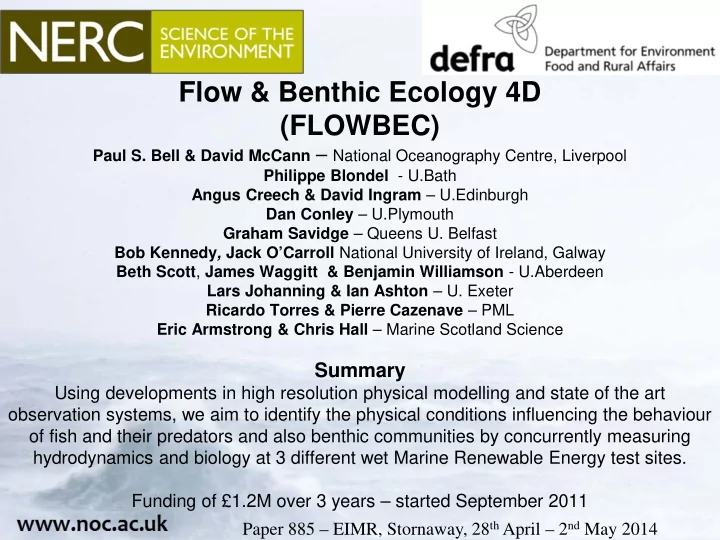

Flow & Benthic Ecology 4D (FLOWBEC) Paul S. Bell & David McCann – National Oceanography Centre, Liverpool Philippe Blondel - U.Bath Angus Creech & David Ingram – U.Edinburgh Dan Conley – U.Plymouth Graham Savidge – Queens U. Belfast Bob Kennedy , Jack O’Carroll National University of Ireland, Galway Beth Scott , James Waggitt & Benjamin Williamson - U.Aberdeen Lars Johanning & Ian Ashton – U. Exeter Ricardo Torres & Pierre Cazenave – PML Eric Armstrong & Chris Hall – Marine Scotland Science Summary Using developments in high resolution physical modelling and state of the art observation systems, we aim to identify the physical conditions influencing the behaviour of fish and their predators and also benthic communities by concurrently measuring hydrodynamics and biology at 3 different wet Marine Renewable Energy test sites. Funding of £1.2M over 3 years – started September 2011 www.pol.ac.uk Paper 885 – EIMR, Stornaway, 28 th April – 2 nd May 2014
Progress: • Activities related to EMEC tide and wave sites • Activities related to Wave Hub • Activities related to Strangford Lough • Application of FLOWBEC related techniques to commercial sites
Activity at EMEC wave and tidal sites At the surface: • Marine Radar monitoring (currents, roughness, bird tracking) • Bird Observations & linkages with measured and modelled hydrodynamics (James Waggitt’s talk – combined work with RESPONSE) Under water: • 5 deployments of the FLOWBEC sonar frame (Benjamin Williamson’s talk) FVCOM modelling (PML)
Radar Flood and Ebb Currents at EMEC tidal site
Survey & Radar derived bathymetry
Small Target (Bird/Beastie) Tracking Target tracks in a single five minute radar record colour = speed (m/s) Images by David McCann (NOC)
Confirmed Orca Tracks (breaching) captured on radar June 18 th 2013 A: FLOWBEC frame deployment vessel B: support vessel C: maintenance vessel D: OpenHydro Test platform Orca Tracks Bird Tracks
FVCOM modelling – Orkney area Images: Ricardo Torres & Pierre Cassenave, PML
FVCOM M2 Ellipses (ORKM POLPRED in red)
Investigating currents & turbulence FVCOM – turbulence Marine radar
Wave Hub • In situ wave and current measurements – focussed on understanding spatial variability (Ian Ashton’s Talk) • HF Radar measurements of currents and wave height – spatial variability of wave height & currents • FVCOM modelling of hydrodynamics – valiadation against various datasets
Arrays of wave measurements High spatial variability in wave measurements from four wave buoys – not artefacts ~ 10% variation in wave power across 500m square area in open sea Wave buoy Water depth Depth Above MSL Buoy locs 50.312 Source term loc B -34 50.311 50.31 -36 D Latitude (Decimal degrees) N 50.309 -38 C 50.308 -40 50.307 -42 50.306 -44 A 50.305 Acoustic Doppler Current Profiler -46 50.304 picture from Ian Ashton – Exeter University -5.674 -5.672 -5.67 -5.668 -5.666 -5.664 -5.662 Longitude (Decimal degrees)
Wave Hub HF Radar Installation • Work ongoing to improve empirical algorithms for wave height determination. • Use of in-situ buoy measurements to develop a site specific correction. • Progress in understanding the factors that can affect wave height measurements
Figure 6. Comparison between two surface current snapshots of the Wave Hub region from the WERA HF radar (right) with FVCOM current predictions at the same times and locations (left). The colour scale indicates current speed, and the box represents the Wave Hub site.
Planned comparison of FVCOM currents with earlier radar data
Strangford Lough • Drop down video surveys of benthic environment – see Jack O’Carroll’s poster • CFD modelling of turbine wake – Angus Creech, U. Edinburgh • Investigate association between turbulent wake and spatial variability in benthos
Images – Bob Kennedy & Jack O’Carroll
Actuator line-modelled rotors and solid supporting structure • Two contra-rotating rotors • Based upon Seagen device operating in Strangford Lough • Additional turbulence generated by structure • Images by Angus Creech U. Edinburgh • Tip vortices and vortex sheets generated • Also from tower / beam structure 18
PentlandX – Radar deployments at Meygen site Demonstration at Meygen Ltd planned tidal turbine array site, Inner Sound of Stroma in the Pentland Firth Paul Bell & David McCann, NOC Liverpool
Acknowledgements • Funders: NERC & DEFRA • Marine Scotland Science – Frame design & construction: Chris Hall, Eric Armstrong, Paul Fernandes • EMEC: The whole team at EMEC • OpenHydro, Atlantis Resources Corporation • Imaginex, Hydro Products • NOC: Colin Bell, Applications Group (POLPRED) & Russell Wynn, MAREMAP Project • Many many others! E-mail: psb@noc.ac.uk Project Web Site: noc.ac.uk/project/flowbec
Recommend
More recommend